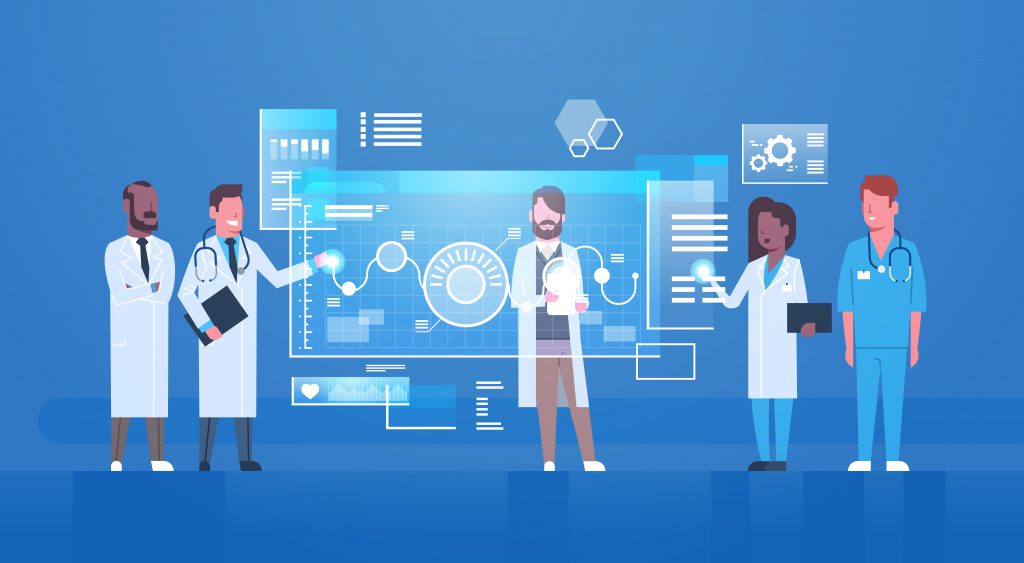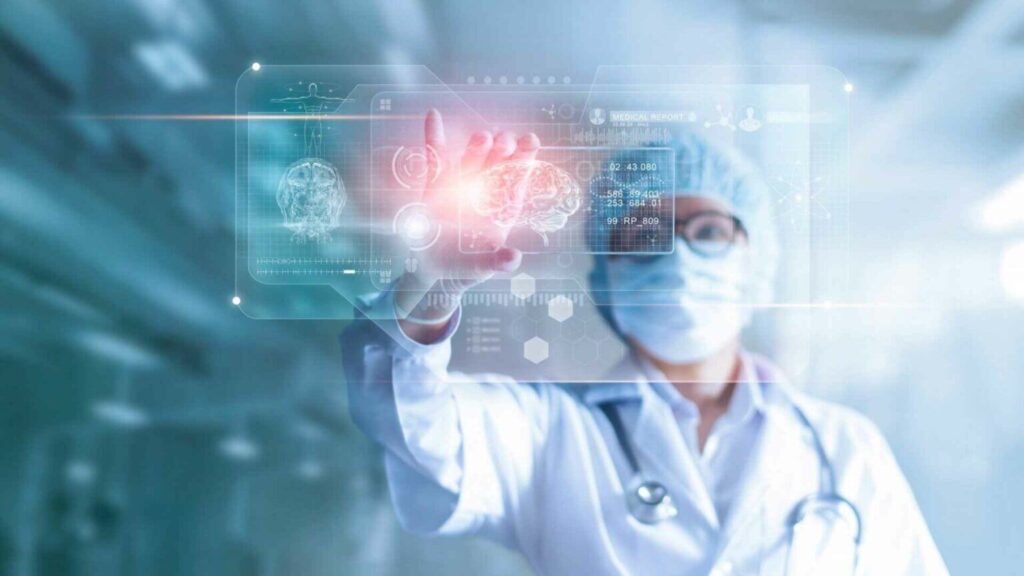Exploring the latest advances in healthcare innovation is critical for extending human life. In this blog post, we’ll look at the leading medical technologies forging a bright future.
The healthcare industry is undergoing a fast upheaval transformation driven by cutting-edge medical technologies. As we investigate the events defining our medical future, knowing both the existing environment and prospective advancements is extremely valuable. This article analyses the state of global healthcare, the industry’s evolution over the past decade, and seven technologies offering great potential to address ongoing health challenges.
The Present and Past of Healthcare Systems

By examining factors like consumer demand for digital services, emphasis on holistic wellness, and collaborations across sectors, we can comprehend the forces transforming healthcare globally. In the past decade, we witnessed revolutionary progress, such as remote monitoring, electronic records, and telemedicine, that have enhanced efficiency, communication, and accessibility. These innovations demonstrate the industry’s commitment to delivering quality care through technological means.
Defining Healthcare Technology
The World Health Organization characterizes health technology broadly as “organized knowledge and skills developed to solve health issues and improve lives.” In practical terms, healthcare technology encompasses tools, systems, medicines, and procedures that support providers’ work. While both advantages and disadvantages exist, the benefits of empowering medical professionals through innovation generally outweigh the limitations.
The Transformational Technologies:

Looking ahead, the following emerging areas demonstrate healthcare’s promising future:
Artificial intelligence shows enormous potential in diagnoses, routine tasks, data management, and more. Combined with robotics, AI can efficiently assist humans.
- Nanotechnology-enabled diagnosis at the molecular level could precisely target damaged cells.
- eHealth applications extend care accessibility via mobile connectivity.
- The Internet of Things allows at-home monitoring through devices like sleep trackers.
- Genomics continues decoding genetics for earlier disease detection.
- Regenerative medicine may replace tissues and organs through engineering.
- Advanced 3D printing creates customized orthopedic implants.
According to research, if successfully developed and implemented, such technologies could significantly reduce global disease within two decades. Continuing to support innovation ensures healthcare systems meet evolving needs while enhancing outcomes. The thoughtful integration of cutting-edge tools maintains the industry’s trajectory toward more effective, equitable, and sustainable care worldwide.
Here are a few additional thoughts on the future of healthcare and medical innovation:
- Personalized medicine will advance rapidly as our understanding of genomics, biomarkers, and individual risk factors improves. Treatments and prevention strategies will become tailored to each patient’s unique biological profile.
- Wearable health monitors and implantable devices will generate vast amounts of real-time data on vital signs, activity levels, and biochemical indicators. Cloud-based AI systems will analyze these digital biomarkers to detect early signs of issues and predict health trajectories.
- Non-invasive and minimally invasive procedures using robotics, nanotechnology, and 3D printing will replace many open surgeries. This leads to less scarring, shorter hospital stays, and faster patient recovery.
- Digital therapeutics employing virtual reality, augmented reality, and smartphones/apps will become a significant part of treatment for physical and mental health conditions. Things like digital pills that communicate when swallowed will also grow in use.
- Multi-omics approaches incorporating genome data, proteomics, and metabolomics will provide a more holistic view of human biology and much better diagnostic/screening abilities than any single type of test.
- Cellular therapies using stem cells, gene therapies, and other advanced approaches will revolutionize how we tackle previously untreatable diseases, from cancer to neurological disorders. Organ engineering may eliminate the need for transplant lists.
Here are some ways AI and IoT could be leveraged to monitor global health better and contain diseases:
- Connected biosensors and health monitors used worldwide could gather real-time physiological and symptomatic data on large populations. AI could analyze this to detect early signs of outbreaks.
- Environmental sensors monitoring factors like air/water quality, climate, and wildlife patterns could provide insight into conditions favorable for specific pathogens. AI risk predictions could guide pre-emptive response.
- Satellite imagery and location data from connected devices could track population movements and behaviors. This aids in modeling disease transmission routes and forecasting hotspots.
- Natural language processing of texts like medical records, news reports, and social media could supplement traditional disease surveillance methods by passively monitoring mentions of symptoms.
- Genomic surveillance of continuously evolving viruses allows AI to quickly identify new variants, assess risks, and advise vaccine/drug development to stay ahead of mutations.
- Connected health records and telehealth solutions would give global health authorities access to anonymized case data whenever and wherever outbreaks emerge.
- Drones and sensors in transportation/public hubs could constantly check for infections via AI-guided screening like thermal cameras or air sampling.
- Coordinated response leveraging this borderless monitoring could rapidly deliver resources like vaccines, masks, and test kits to areas most vulnerable to contagion spread.
In a nutshell, AI and IoT open possibilities for continual, widespread, multimodal global health oversight that was not feasible before these technologies became integrated into our world.
Here are some ways AI and IoT could help advance vaccine and drug development:
- AI can analyze massive datasets from genomic surveillance, clinical trials, and published research to discover new drug targets faster than human researchers alone.
- IoT-enabled labs and tools can continuously generate real-world evidence on efficacy and side effects to accelerate clinical trials and FDA approval processes.
- AI and automation enable high-throughput virtual and wet-lab experiments to screen millions of potential drug candidates in silico, cutting years off development.
- Connected monitoring devices capture comprehensive real-world data on patients’ medication usage patterns and responses to support precision dosing and combination therapies.
- AI helps optimize vaccine design by simulating how antigens interact with the immune system and simulating strain evolution to pick the most robust candidates.
- IoT sensors monitor the supply chain and ensure optimal temperature control of perishable vaccine shipments for deployment in low-resource areas.
- Global health monitoring via AI and IoT will help tackle public health crises on a scale impossible. Diseases will be identified and contained much more quickly worldwide.
- Connected clinics paired with AI dashboards give global health experts insights to coordinate R&D efforts, spot opportunities for new combo therapies, and get the right interventions to affected populations faster.
- Digital twins of patients and diseases powered by real-world data on molecular pathways can discover new usages of existing drugs and personalized treatment approaches.
By leveraging AI and IoT, the entire drug/vaccine R&D cycle, from target identification and design to clinical trials and deployment, can be vastly accelerated and optimized for more significant public health impact.
Here are some potential challenges and limitations of implementing AI and IoT in vaccine and drug development:
Data Quality and Accuracy – Models are only as good as the data they train on. Noise or biases in real-world datasets could undermine predictions.
Explainability – Complex neural networks may find patterns, but explaining their reasoning process is challenging, which undermines trust for use in regulated domains like healthcare.
Technical Failures – Reliance on continuous connectivity, computing infrastructure, and device functionality poses reliability risks, especially in remote areas.
Security/Privacy – Large connected networks and health data repositories raise serious concerns about hacking, data breaches, and inappropriate dissemination of sensitive personal information.
Regulatory Hurdles – Government oversight bodies may struggle to keep regulations aligned with rapid technological advances, slowing the implementation of new tools and approval of products.
Skills Gap – There is a lack of data science/AI experts with domain expertise in biomedical research, hampering the practical application of these techniques.
Cost – Establishing global networks of connected devices, data centers, and computing power requires massive investment, which may not be feasible for all regions/challenges.
Bias – Models risk amplifying existing inequities or access gaps if not developed and applied judiciously across diverse populations.
Unexpected Consequences – Emerging technologies can have unintended impacts that were not foreseeable during development.
Careful consideration of limitations like these is critical to mitigating risks and building public trust as AI/IoT transforms drug and vaccine R&D.
FAQ’s – Frequently Asked Questions
1. Is AI safe to use in healthcare?
All new technologies require responsible development and oversight to minimize risks. With proper training on diverse datasets, transparency into model logic, and human oversight of critical functions, AI shows promise to augment but not replace clinical judgment. As with any tool, the focus must remain on patient outcomes and well-being.
2. Will connected devices compromise my privacy?
Privacy and security are top priorities for any healthcare IoT system. Strong encryption, anonymization techniques, and strict access controls help ensure only necessary personnel can access data on a need-to-know basis. Still, patients have a right to understand data usage and consent to what is collected. Transparency builds trust that personal information stays private and secure.
3. How will AI and IoT change the doctor-patient relationship?
These technologies are intended to support, not replace, the essential human connection between providers and those they serve. AI can flag issues for doctors to review while reducing routine workloads. Connectivity increases access to care while patients remain in control of personal devices and data. With change comes the opportunity to shift focus toward empowering individuals in self-management and prevention.
4. How will healthcare workers’ jobs be impacted?
Many routine tasks will be automated through AI, but this frees clinicians to spend more time with complex cases requiring human skills like empathy. Overall, healthcare will still need more caregivers to serve aging populations. New skills will be required to work alongside technology, leading to higher-level roles overseeing AI systems and analyzing vast amounts of data to optimize patient care.
5. When will these technologies become widely available?
Many applications are already in use today, and rapid innovation is predicted to continue this pace of change. However, thorough testing is required before unproven tools impact widespread clinical practice. While some regions adopt sooner, global access will vary. A combined effort across industry, providers, and policymakers can help speed responsible innovation to those who need it most through open-source sharing and tailored solutions.

